For anyone planning to build a website using content management system (CMS), Drupal Vs WordPress Vs Joomla seems to be the No. 1 question in mind. Well, choosing ONE among the BEST 3 options is always a tough task, especially when there are many similarities. Therefore, I have tried to help users choose the right CMS platform by making a full comparison along with a brief overview of the similarities.
First of all, these three platforms (WordPress, Joomla, and Drupal) have been successful in dominating the CMS world consistently since 2010. As for today, WordPress is the king of all CMS platforms which powers over 58% of all CMS based websites. Second and third in the row, Joomla has the 7% of CMS market share while Drupal powers over 4% of all websites using CMS platforms. Comparing the market share, WordPress seems to be far ahead of Joomla and Drupal, however, there are multiple aspects in which WordPress falls behind.
So, I will be comparing these three platforms from 4 different points as given below.
- Introduction
- Ease of Use
- Design and Functionality
- SEO, Security, and Support
What are the similarities among WordPress, Joomla, and Drupal?
Before I start describing the differences, I have to state the major similarities among these three platforms. Let’s see the similarities in the points below:
- All the three platforms WordPress, Joomla, and Drupal are open source free software licensed under GPL. Therefore, you can download the software free, use, and modify as you like.
- All the three platforms have developed a community of their own consisting of developers, designers, trainers, users, and volunteers. The communities are aimed at making the platform a better CMS by sharing the knowledge, supporting the users, organizing events, solving the issues, and more.
- All the three platforms are based on PHP and MySQL.
- All three of them use themes/ templates for the design and plugins/ extensions/ modules for adding functionality and features.
As mentioned above, these three platforms are basically Content Management Systems and provide quite a similar platform. However, if you take a closer look, you will see different ways and processes they take to create a website. So, I have tried to provide a detailed description of the differences below.
Are you in a hurry?
If you want to see the summary of the comparison of the best three CMS platforms, see the table below.
Drupal Vs WordPress Vs Joomla: The CMS War
| CMS | WORDPRESS | JOOMLA | DRUPAL |
| About (What they say about themselves) | WordPress is open source software you can use to create a beautiful website, blog, or app. | Joomla! Is an award-winning content management system (CMS) which enables you to build websites and powerful online applications. | Drupal is content management software. It’s used to make many of the websites and applications you use every day. |
| Software | FREE and Open Source | FREE and Open Source | FREE and Open Source |
| CMS Market Share(W3Techs) | 58.9% | 7.0% | 4.7% |
| Installation | One-click Install or manual installation manually within 5 minutes | One-click Install ormanual installation within 10 minutes | One-click Install ormanual installation within 10 minutes |
| Ease of Use | Beginner-friendly (5/5) | Somewhat Beginner-friendly (4/5) | Requires Coding Skills (3.5/5) |
| Design (Themes & Templates) | 4500+ Official FREE Themes9500+ Premium Themes at ThemeForest | NO Official Template Directory950+ Premium Joomla Templates at ThemeForest | 2000+ Official Drupal Themes450+ Premium Drupal Themes at ThemeForest |
| Functionality (Plugins & Extensions) | 50,000+ Official FREE Plugins (Thousands of Paid Plugins on the web) | 7500+ Official Extensions (FREE+Paid) | 37,000+ Drupal Module at Official Directory |
| Websites Using this Platform | Chicaco Sun Times, Vogue India, Katy Perry & More. | Michael Phelps – MP Brand, Discover Magazine, French West Indies & More. | US. Department of Energy, University of Minnesota & More. |
| Website | Visit WordPress | Visit Joomla | Visit Drupal |
Hope this table gave you some sort of idea.
Now, let’s start the full review of the three best CMS platforms:
1. Drupal Vs WordPress Vs Joomla: Introduction
WordPress, Joomla, and Joomla all three CMS software were introduced in the early first decade of the 21st century. Drupal was first released in 2001 by Dries Buytaert while WordPress and Joomla were released in the year 2003 and 2005 by Matt Mullenweg and Mambo team respectively.

In the short period of less than 20 years, these CMS technologies have changed the way people make websites. CMS platforms have evolved as the perfect website platform for the non-coding normal users that is easy and quick setup and easy to manage while being cost-effective.
What is Drupal?

The oldest CMS among the compared three platforms here, Drupal is the third most popular CMS platform in use. It was released in 2001 by Dries Buytaert. More than 4% of CMS based websites on the web are created using this platform. Drupal focuses on providing standard features including reliable performance, strong security, and reliable customizability. There are millions of websites using Drupal as the CMS software including government agencies, eCommerce, blogging, education and other various industries.
Drupal has a huge open source community with more than one million dedicated developers, designers, trainers, strategists, editors, and sponsors worldwide. In addition, it has working and regional groups and meetups taking place in different parts of the world. Besides, DrupalCon events are organized where users can take skill training and level up their skills.
What is WordPress?
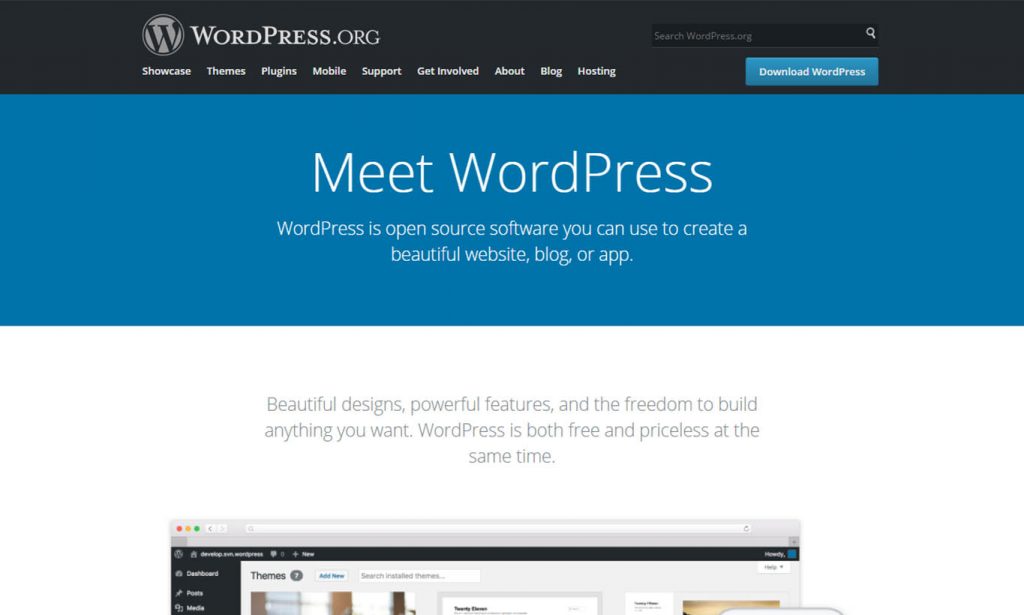
WordPress is the #1 most popular CMS platform today which powers over 27% of all websites which is 59% CMS market share. First introduced as a blogging platform in 2003 by Matt Mullenweg, WordPress has evolved as a complete Content Management Software in the matter of few years. It became unbelievably popular for its user-friendly approach i.e. providing a simple and highly intuitive platform where non-coding users can build a complete website and run it.
There are all types of industries and professionals using WordPress platform nowadays. It is used by popular magazine sites like New York Post and BBC America, celebrities like Brian Smith, blogs, business sites, eCommerce sites and government agency websites. In addition, WordPress has developed as a giant global community with millions of enthusiastic members including developers, designers, users, and volunteers. Besides, there are region or country based WordPress communities across the world which organize various events like WordCamps, meetups etc.
What is Joomla?

Joomla is the second most popular content management system used by 7% of the CMS based websites. The first version of Joomla was released in 2005 as the rebranding of the Mambo CMS by an Australian Company. Among the three CMS platforms compared here, Joomla seems the youngest, however, it has already earned lots of public interest as it offers an amazing platform for building websites.
Since the release of the software, millions of websites have used it worldwide. There are all types of websites including business, educational, entertainment, government, health, and technology. Joomla also has a huge open source community with millions of Joomla lovers across the globe. The community works for providing support to its members, organizing events, and helping to improve the platform for making it better than ever.In the nutshell, Drupal is a developer focused standard platform, WordPress is a user-friendly platform focusing simplicity and Joomla is a platform somewhat beginner-friendly but falls behind WordPress regarding ease of use. Joomla platform lies somewhere between WordPress and Drupal with regards to user-friendliness and customizability.
2. Drupal Vs WordPress Vs Joomla: Ease of Use
Having an online presence is vital for every individual or organization but not all the people are web developers. Most people have no coding skill at all. Well, CMS platforms provide quite an ideal platform for the non-coding people, however, user-friendliness is not given the same priority by all platforms. So, let’s see which platform is the best at user-friendliness.
Ease of Use: How to use Drupal?
First of all, Drupal installation is no pain as most of the web hosting companies offer one-click installation. Next step is to set up your site with the site information including site name, slogan (tagline), and email address.
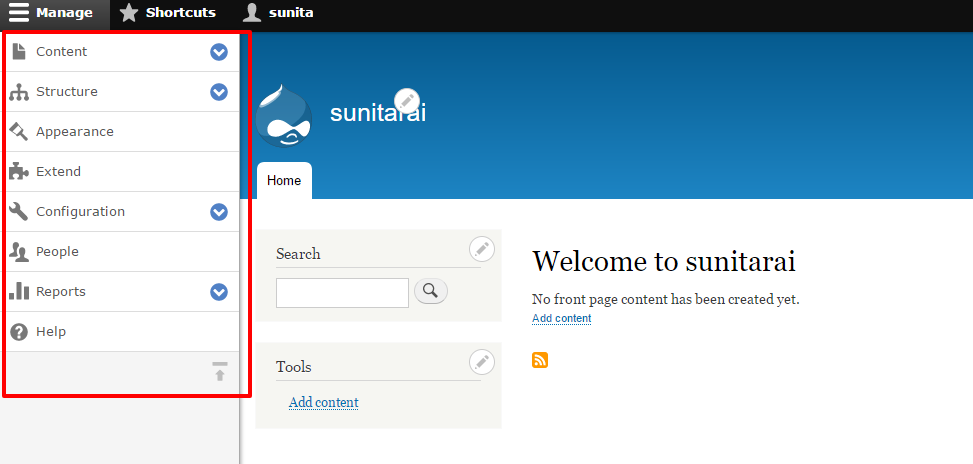
Drupal dashboard looks simple and clean with a minimal layout. As shown in the image below, you can see eight menus in the left sidebar.
Here is the brief description for each menu:
- Content: Add articles and basic pages from here. Articles are similar to WordPress posts and Basic pages are similar to WordPress pages.
- Structure: You have the complete control of the website elements in this menu. You can add, edit and manage various elements like Block layout, Comment types, Contact forms, Content types, menus etc from here.
- Appearance: You can add and customize Drupal themes here.
- Extend: Drupal modules work as the plugins to WordPress. They add functionality to a Drupal website. You can see the list of installed modules, install new modules and manage them from ‘Extend menu’.
- Configuration: It works as administrator panel where you can find account settings, basic site settings, media settings, Search engine indexing settings etc.
- People: Drupal allows multiple users. You can add new users, assign status, role, and permission to the users via this menu.
- Reports: It is where you can check out available updates, recent log messages, field list, status report and more.
- Help: Few steps on getting started with Drupal.
As the first step of customizing the site, you have to decide on the design and look of the website for which you must go to ‘Appearance‘ menu. As you click on the appearance menu, you’ll see a theme control page like in the screenshot below. It has two themes installed by default and option to ‘install a new theme’.

Well, Drupal dashboard looks simple until here but it may not be the same until you can create a site good enough to go live. Drupal is widely known for its massive flexibility while this has disrupted the simplicity. Drupal core software focuses on making this platform strong and secure which is why limited features in it. Everything you want to extend must be done with the modules.
It has a great collection of the modules for almost any feature but finding one is not that easy. It takes you time to learn about the modules, pick one, add and manage it the proper way. In comparison to the two other CMS platforms discussed here, Drupal is difficult. It has extensive flexibility while it is focused on developers, not the beginners.
Ease of Use: How to use WordPress?
Most of the WordPress hosting companies provide WordPress installation feature with single-click install. Therefore you can easily install WordPress and start with setup. The same website setting up step applies here, add site name, email address and start your WordPress site.

WordPress Dashboard is simple and user-friendly which highlights the useful options. The image below is the screenshot of how your WordPress dashboard looks at the beginning.
Now, let’s have a quick look at the major parts of WordPress dashboard.
- Home: Home is where you are now. It is the default page for the WordPress dashboard.
- Updates: WordPress has frequent updates in the core software along with the themes and plugins. You can check the available updates and operate if available.
- Posts: You can add general posts or blog articles from here. Additionally, add post tags and categories from there.
- Pages: You can add pages like ‘Home’, ‘Contact Us’, ‘About’ etc. from there.
- Comments: All the comments from the site users will be available here.
- Appearance: Appearance in the WordPress dashboard is the vital menu. You can make complete control the design of the website via this menu. It includes themes, customize, widgets, menus, header and CSS editor.
- Plugins: Plugins are the handy tools for adding functionality. You can see the installed plugins and also add new plugins via this menu.
- Users: WordPress supports multiple users. You can manage all the website users from this menu.
- Tools: By default, it has ‘import’ and ‘export’ tool in this menu.
- Settings: Another very important section in the WordPress dashboard is ‘Settings’. You can see all the site configuration options here as general settings, writing, reading, discussion, media, and permalinks.
- Collapse menu: Well you can collapse the menu if you want to have the full-width for managing content.
Now as the first step, choose a theme for your website. By default, there are some WordPress default themes like Twenty Seventeen, Twenty Sixteen, and Twenty Fifteen. If you want a new theme, you can simply add by clicking on ‘Add New’.

Well, WordPress dashboard is simple and will be simple for the rest of the time as well. You can now customize the active theme by going to the ‘Customize’ in the appearance menu. If you want a simple blogging site, you can just add some content and you are ready to go live. For other types of websites, you must be careful while choosing a theme as most of the WordPress themes come ready for the specific type of features.
If you don’t find a feature you are looking for, simply search for a plugin in the WordPress plugin repository or on search engines. Then install the plugin and you’ll be ready with it. It is fairly easier to work with WordPress themes and plugins than Drupal themes and modules. Hence WordPress is the most beginner-friendly platform.
Ease of Use: How to use Joomla?
Installing Joomla is simple as installing WordPress and Drupal, i.e. single click installation by the hosting companies. After installation is done, you need to start website setup and configuring website.

Joomla dashboard seems a bit stuffed in comparison to the other platforms Drupal and WordPress. As you can see in the screenshot below, it has more sections; separate sections.
Let’s learn what the Joomla Control Panel comprises.
- Content: Content menu has four other sections New Article, Articles, Categories and Media. It works just a WordPress posts.
- Structure: You can add and configure menus and modules from here.
- Users: Add and manage user groups, access levels, user notes and more from this menu.
- Configuration: It is the most significant menu in the Joomla control panel. It has ‘Global Configuration’ for the site, the option to ‘templates’ and ‘language’ settings.
- Extensions: Joomla extensions work as WordPress plugins which add functionality to the website. This menu has the option to install new extensions and manage them.
- Maintenance: It shows if the Joomla core and the installed extensions are up to date.
Apart from the control panel in the left sidebar, it has more menus in the top of the page. Most of the left sidebar menus are there along with one additional menu ‘Components‘ there. It has various options including banners, contacts, Gallery, messaging etc.
Same as WordPress and Drupal platform, Joomla also uses templates for design and look. With the Joomla installation, there are two default templates pre-installed.
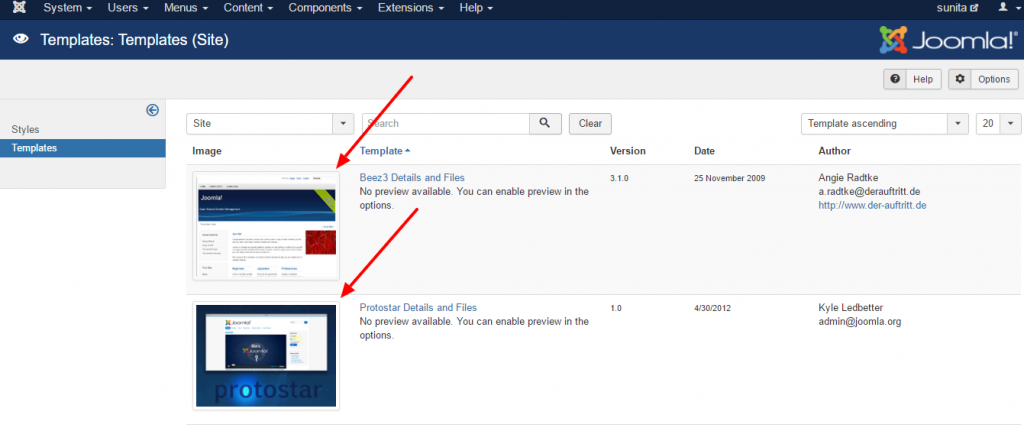
Well, Joomla dashboard looks vague at the first sight. Furthermore, configuring it also can be more confusing for the beginners. Add the article just like in WordPress but managing it looks difficult. You must add the modules and also arrange the positions. It takes some time to understand the interface. Once you understand its way, it becomes easy.In the nutshell, WordPress is unquestionably the WINNER regarding user-friendliness. If you are a beginner and want a quick, feature-rich and nice solution to create a website, WordPress is the perfect pick. If you have some time and patience to learn, Joomla must be a good choice with plenty of features and flexibility. And, Drupal must be your choice if you have mastered in web development.
3. Drupal Vs WordPress Vs Joomla: Design & Functionality
All the three platforms use themes and templates for managing design. Similarly, they use plugins, modules, and extensions for adding features and functionalities.
Drupal Design and Functionality
Drupal is unbeatable regarding its flexibility and features. It has a powerful core software that is security proven and has enhanced performance. In order to add functionalities, you have to install modules. The design of a Drupal site is based on the theme.
Drupal has a huge collection of free themes. The official Drupal theme repository has 2000+ Official Drupal Themes.
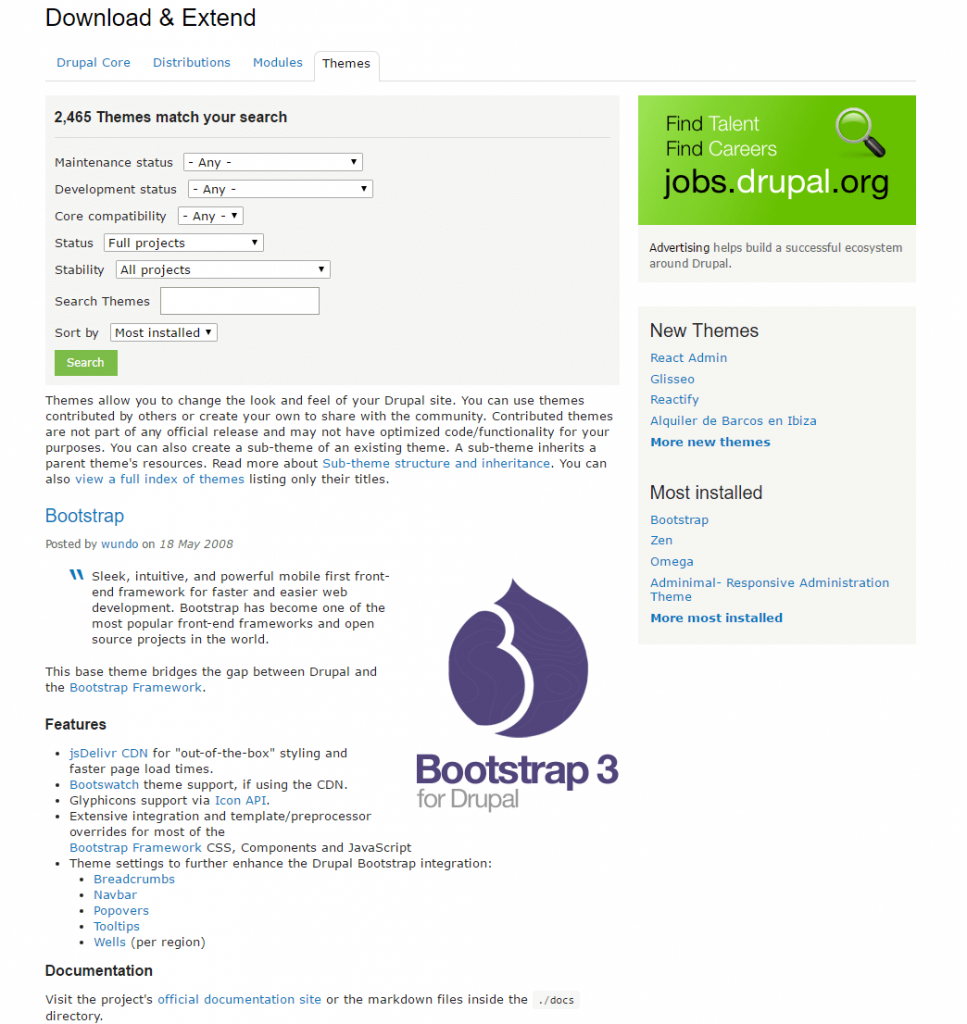
In addition, there are 450+ Premium Drupal Themes at ThemeForest which you have to purchase, download and upload to your Drupal site.
Drupal modules are vital for adding functionalities and features. There are 37,000+ Drupal Modules at Official Directory. This makes it sure that you can get a module for almost any feature.
Drupal is highly flexible and extendible however the learning curve makes it a less appropriate option for beginners. Drupal is a perfect platform for those willing to create a powerful website and have coding skills or have plenty of time to learn.
WordPress Design and Functionality
When it comes to design and functionality with ease of use, WordPress stands out of all the other platforms. Most of the WordPress website design is dependent on the theme used. There are tons WordPress themes and templates available on the web which means unlimited design possibilities with WordPress.
WordPress has a huge collection of themes at its official theme directory. There are 4500+ Official FREE Themes available there. The advantage of using the WordPress platform is direct access to these official free themes from the WordPress dashboard. As you click on the ‘Add New’ in the ‘Themes’ menu, it takes you to the theme directory which is not possible with Drupal and Joomla.

In addition, there are 9500+ Premium Themes at ThemeForest which is a huge number. The number of themes and templates available for the two other platforms Joomla and Drupal are far less than this.
Besides, there are hundreds of independent third party WordPress development companies like ThemeGrill who provide quality WordPress themes and plugins. If you search ‘Best WordPress Themes’ on Google, you will be surprised to see the huge number of companies and the competition among them.
WordPress plugins are the tools for adding features and functionalities to a WordPress site. You can add any type of feature including SEO, security, speed, marketing, eCommerce etc. using WordPress plugins. Just like the WordPress themes, there are unlimited plugins for WordPress. There are 50,000+ Official FREE Plugins while you can find thousands of Paid Plugins on the web.
This makes it clear that WordPress is the No.1 platform with the huge collection of themes and plugins. The design possibilities and functionality options are limitless.
Joomla Design and Functionality
Same as Drupal and WordPress, Joomla also uses templates for design control. However, Joomla offers comparatively fewer options than Drupal and WordPress. It has NO Official Template Directory like WordPress and Drupal have. You must go to the third party theme makers’ websites for Joomla themes. Therefore there are some (fewer) FREE Joomla themes available.
If you want a paid template, you can go the theme marketplace ‘ThemeForest’. There are 950+ Premium Joomla Templates at ThemeForest.
Just like WordPress plugins and Drupal modules, Joomla extensions are useful for adding functionality and features. Though it has no template directory, it has a feature-rich extension directory. There are 7500+ Official Extensions (FREE+Paid) in the official Joomla extension directory. One good point about using this platform is direct access to these extensions right from the Joomla dashboard.

Therefore, Joomla is a minimal platform with limited templates. This is a plus point if you don’t want to get lost with a huge number of options. It is precise and simple.In the nutshell, Drupal is a great platform with unlimited design possibilities however the learning curve may be once again the limitation. WordPress is awesome which offers highly customizable design along with ease of use. And Joomla has a comparatively fewer design options but plenty enough for a complete website one ever needs. In conclusion, Drupal is the perfect choice for developers with higher custom design needs. WordPress is perfect for the users who want both ease of use and flexibility. And Joomla is a great choice for those who want a quick pick from the selection of templates and need a simple framework.
4. Drupal Vs WordPress Vs Joomla: SEO, Security, and Support
WordPress, Joomla, and Drupal all these three platforms have been created using certain security standards. Drupal core is by default a strong platform, while Joomla and WordPress also are secure if you carefully handle the security issues.
With regards to SEO, WordPress is surely at the top as it has its history of beginning as a ‘blogging platform’. It has an SEO friendly framework with categories, tags, and plenty of SEO plugins. Drupal and Joomla also have various modules and extensions for SEO and marketing.
Support is another very important aspect one must consider while choosing a platform. Since all three platforms WordPress, Drupal, and Joomla are Community-based platforms, one can get plenty of support and resources. You can contact the community support forums or go to the documentations for solving the issues.
Wrapping Up
Doubtlessly, these three platforms are the best CMS platforms available today so picking up any one will not be waste of time. However, you will be truly wise if you can draw clear distinctions within and choose the one that actually fits your needs.
So, I hope that this article is useful for you to start a website with the RIGHT platform.
Have any thoughts on this post?


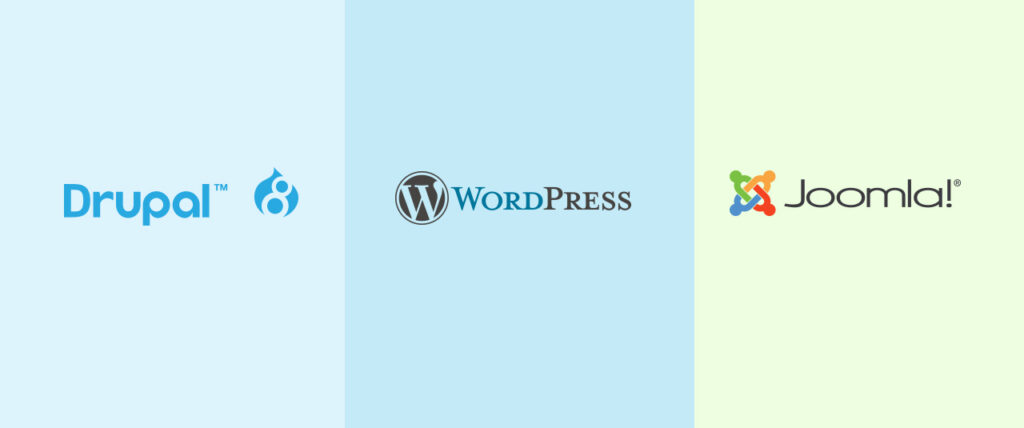
Pingback: Build a Website - Start to Finish Guide with InterWeb SA - InterWeb SA